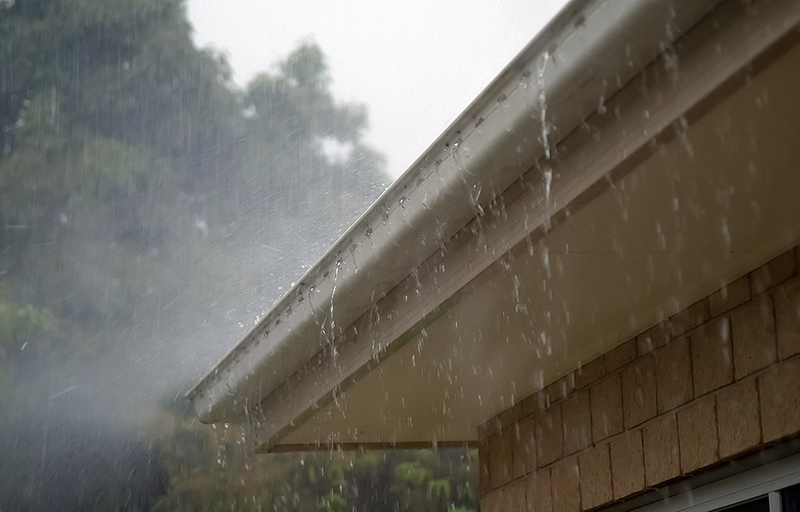At Aapex Construction & Restoration, we stress the importance of properly maintaining your home’s gutters, especially in helping to prevent ice dams from forming along the edge of your roof. Many of our customers ask us whether it is a good idea to install gutter guards in order to avoid the hassle of cleaning out the gutters. Some have heard that gutter guards can also make ice dams worse in the winter. Here we aim to answer some of these questions, giving our own opinion of the pros and cons of installing gutter guards.
What is a Gutter Guard?
Gutter guards are devices installed in or on your gutters to help prevent leaves and other debris from entering the gutters and causing clogs. There are four main types of gutter guards, each offering its own benefits and drawbacks.
Screen Guards
This is a guard the covers the entire gutter with a perforated screen, allowing water to freely flow into the gutters while preventing most debris from finding its way in. These are the most commonly installed type of gutter guard, and for good reason. Screens work well in situations where leaves are the biggest issue. With that said, openings in some of these screens are often big enough to allow smaller debris, such as pine needles and seeds, into the gutters, sometimes even clogging the gutter screens themselves. Removing this debris requires removal of the gutter screens. If your home has a lot of evergreens nearby, micro mesh gutter guards may be a better option.
Micro Mesh Gutters
Similar to screen guards, micro mesh guards cover the entire gutter, which prevents even small debris (as small as 50 microns in diameter) from entering the gutters. While this guard is quite effective at keeping debris out of your gutters and downspouts, heavy rains will often skate across the screens, preventing your gutters from doing their job of draining your roof and keeping water away from your foundation. These guards do allow some very small debris through, so periodic cleanings will still be required to ensure your gutters do not become clogged.
Brush Guards
These guards resemble the head of a fat bottle brush and are laid inside your home’s gutters to prevent debris from entering into your gutters while allowing water to pass through. These work especially well at preventing larger debris from clogging your gutters, and they are nearly invisible from the ground. However, smaller debris does get caught in the brushes, and they will need to be cleaned more frequently than other guard options. Another big complaint about these guards is that it is very difficult to completely clean the bristles, thus diminishing the guard’s effectiveness over the long haul.
Foam Guards
Similar to the brush guards, the concept behind foam guards is to intentionally block the gutter, preventing debris from filling it, but with a material that allows water to pass through. The foam is highly porous and does not significantly interfere with the gutter’s efficiency. However, gutters with foam guards will still need to be cleaned more frequently to clear out the debris that has collected on top of the guard. In some instances, these foam guards have also promoted moss growth inside the gutter. During the winter, these guards may become water-logged with freezing water that quickly turns to ice once it has found its way into the foam.
Reverse Curve (aka Surface Tension) Guards
These guards use physics to keep debris at bay. First patented by George Cassens in 1908, these guards are installed on top of your home’s gutters and are slightly curved downward. Due to water’s surface tension, it will follow the curve of the guard to flow freely into your home’s gutters, while debris flows away from the gutter and falls to the ground. These gutters are very effective at keeping debris from entering the gutter during a rainstorm; however, smaller debris can easily find its way into the opening and eventually clog the gutters. Similarly, leaves often collect along the edge of the curve and may completely block water from entering your gutters. Because they are the heaviest and bulkiest guard option (and are professionally installed), removing these guards for periodic cleaning can be a bit of a hassle.
Do Gutter Guards Prevent Me from Having to Clean My Gutters?
While gutter guards may increase the amount of time between cleanings, they absolutely do not completely eliminate the need to regularly clean your home’s gutters. Depending on the type of guards installed on your home, you may still need to clean them every 1-3 years. At the very least, your gutters need to be regularly inspected, and all loose debris will need to be swept off the surface of your guards.
Do Gutter Guards Cause Ice Dams?
One of the biggest misconceptions about gutter guards is that they cause ice dams. Gutter guards do not cause ice dams, but improperly maintained gutters and gutter guards can certainly contribute to the creation of ice dams. Ice dams caused by poor insulation and ventilation in your home’s roof can be exacerbated when gutter guards are present because they provide more surface area upon which ice can cling. Some guards, such as the foam and brush versions, can also hold onto more freezing water, allowing it to become ice as it slows in the gutters. The biggest issue gutter guards present in the winter is if ice dams do form, they become more difficult to remove because the gutter guards are present.
Is your home’s roof properly insulated and ventilated to protect against the formation of ice dams this winter? Contact us today to see how we can help keep you dry this winter.

